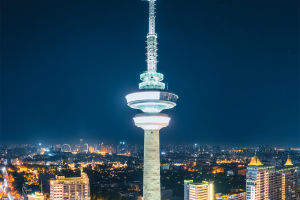Landscape photography is not difficult, and some of the techniques are quite simple. Today, we are sharing a few tips for taking beautiful landscapes.
Get A Dynamic Shot
Landscape photos don't have to be static! If you have a tripod, try slowing down the shutter speed to record the movement of clouds, flowing water, car tracks, people, etc.
This will give you more variety in your photos and will also allow you to capture situations that are not visible to the human eye. Note: If you are shooting in the daytime with a slow shutter speed, you may need to add an ND filter to reduce the amount of light coming in, otherwise the photo will be overexposed.
Pay attention to the sky when photographing a landscape outdoors, as it is inevitable that the sky will be included. When the sky is clear, consider focusing on the sky, which can sometimes take up two-thirds of the photo. When the sky is dull, don't shoot too much of the sky, but mainly focus on the scenery as the main character. The clouds in the sky can also be the focus of a photo, especially if the wind is strong, and you can capture stray clouds using long exposures.
Discovering the Best Time to Shoot
Timing is a very important element in taking good landscape photos! The time of day when it is easiest to get the best shots is the 'Magic Hour', the 30 minutes before and after sunrise.
This is when the sky changes from warm to cold, and with the right amount of clouds, you can see the "burning clouds" phenomenon! It is also important to check when the spot is lit, back-lit, or top-lit, as this can affect the results.
When photographing the stars, you should also check the position of the moon and try to avoid the moonlight to make the stars clearer. Of course, if time permits, you can visit the target spot at different times to see when it is most suitable for shooting.
Keep An Eye On The Horizon
Whether you are photographing the sea, a hill, or a building, it's always a good idea to keep an eye on the horizontal line. Unless you want to make a special effect, a sloping horizontal line can ruin the beauty of a photo!
If you want to accentuate the sky, drop the horizontal line a little and try not to put it in the middle (except for reflections).
Using A Gradient Grey Filter
The light in the mountains is complex and you will often have problems with either overexposed skies or no detail in the shadows. This is why a graduated grey filter becomes necessary. With a gradient grey filter, you can balance the exposure of the sky with the landscape on the ground and get even better photos.
Keep an eye on the impact of depth of field as a photographer. You will know that the depth of field can make a difference in how blurred a scene is, especially in the background and foreground. We can make good use of depth of field when taking landscape photos. If we want the whole scene to be sharp and clear, we need to use a deep depth of field (small aperture, e.g. f/8, f/16, etc.).
If we want to highlight the subject by blurring the foreground or background (e.g. shells on the beach, details of buildings, etc.), we use a shallow depth of field (large aperture, e.g. f/1.4, f/2.8, etc.), but of course, the aperture is only one of the elements that affect the depth of field.


